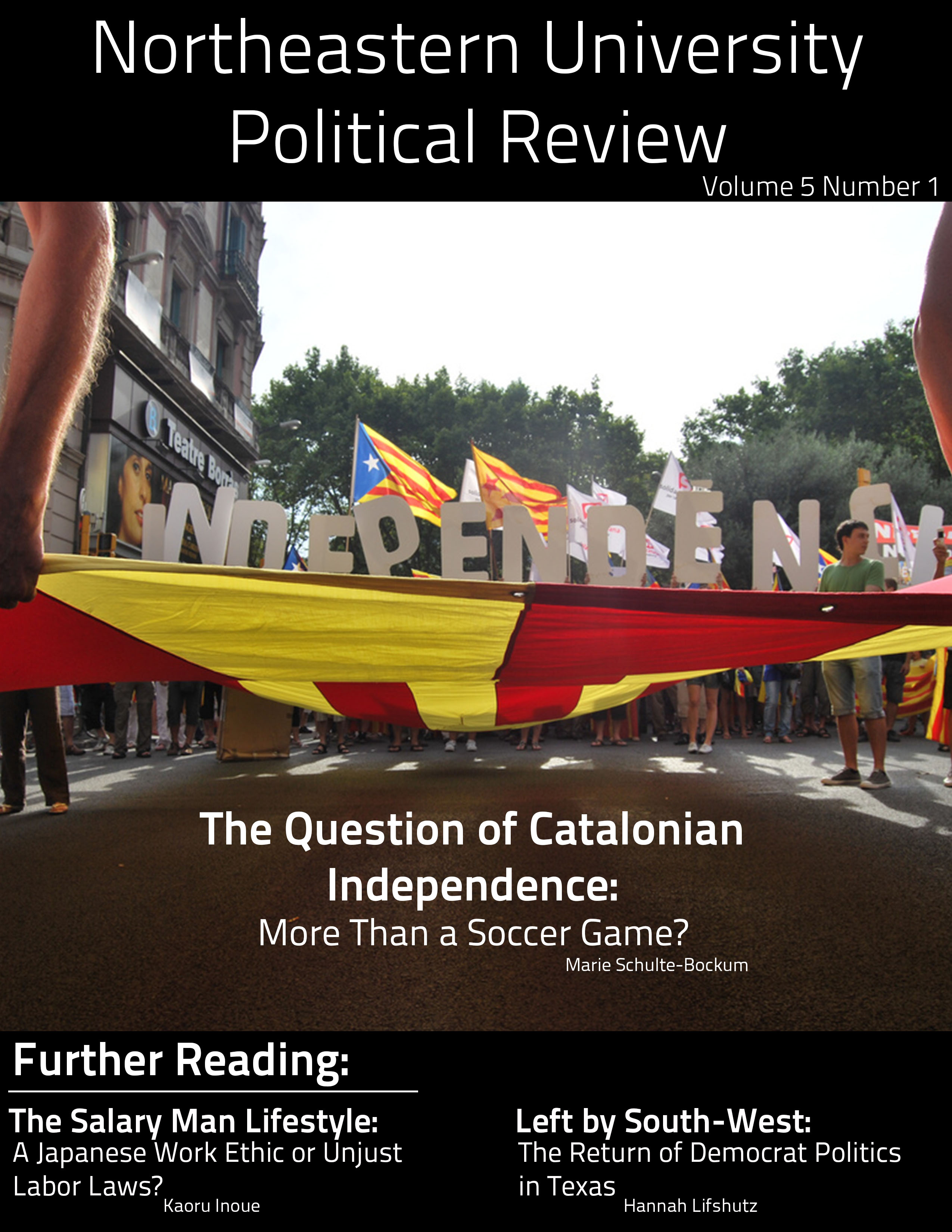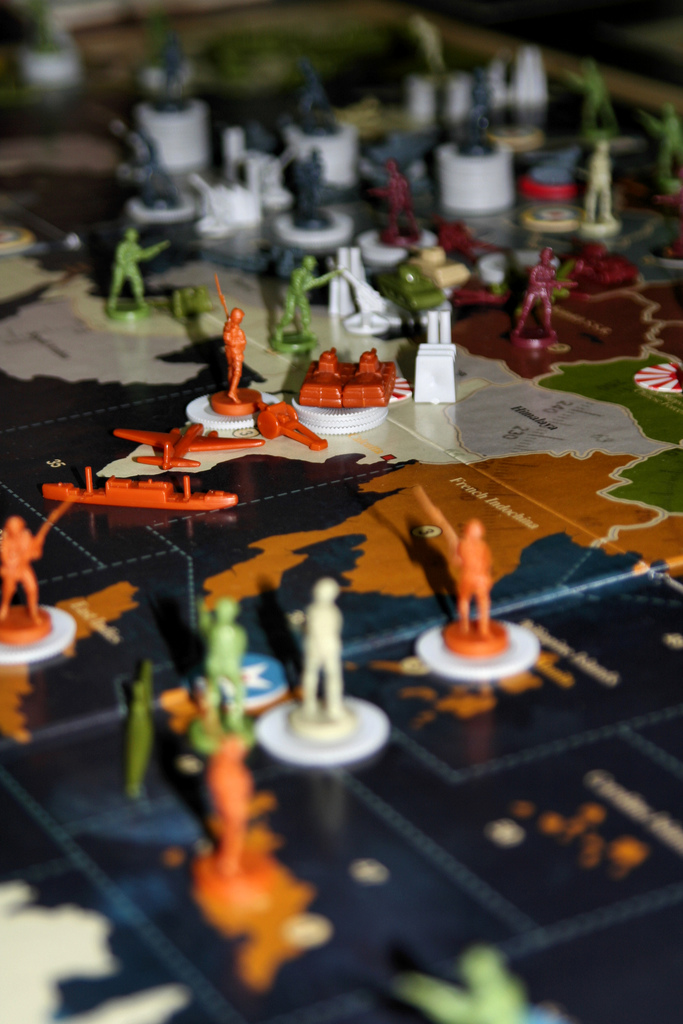Most people would be forgiven for thinking that the peak of the Catalonian campaign for independence from Spain is the infamous El Clasico soccer derby, Real Madrid vs. FC Barcelona. FC Barcelona recently won 2-1 against Real Madrid on its home turf, the Camp Nuo stadium. On March 13th, 2013, El Clasico will come to Madrid’s Bernabeu arena. In front of a global television audience of 700 million, the Barcelona team will walk into the Madrid stadium wearing away game jerseys marked with the stripes of the Catalonian flag.
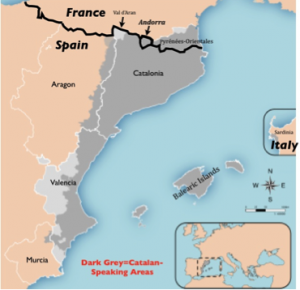
Yet soccer is only one example of recent friction between Catalonia and Spain. On Catalan Independence Day this year, Catalans formed a 250-mile long human chain stretching from the French border to Valencia in an impressive show of collective strong-will.[1] Unlike other independence movements such as the Scottish struggle against the UK, the Catalonian desire for independence is not new. It is rooted in a centuries-old history of oppression by the Spanish state, and it is discernible through a unique language, culture and capital. As the Catalan historian Jaume Vicens Vives puts it, “The defining element of the Catalan psychology is not reason, as for the French; intelligence, as for the Italians; or mysticism, as for the Castilians. In Catalonia, the primary feature is the desire to be.”[2]
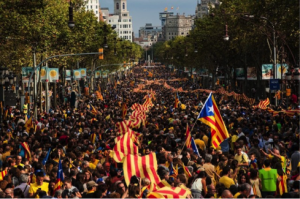
Language is one of the major factors reinforcing a distinct Catalonian identity. The Catalan language itself is ancient. Written records of it date back to the 11th century, the same era that holds evidence of French and Castilian Spanish documents. Ever since then, successive Spanish leaders have sought to cut off the Catalan tongue by force. Most famously, authoritarian General Francisco Franco forbade the speaking of it during the Spanish Civil War with the slogan “una bandera, una patria, una lengua”, translating to “one flag, one country, one language.”[3] As a recent Spanish census shows, such endeavors did little to kill the Catalonian spirit, and nothing to silence the Catalan people: a mere 5 percent of Catalans said they did not understand Catalan, compared to 52 percent in the Basque autonomous region population, which doesn’t speak the Basque dialect.[4] The unique language underpins many of the Catalonian cultural customs, such as the singing of the official national anthem, El Segadors (The Reapers). The lyrics, frequently voiced at government occasions, sporting events, and tourist attractions, certainly do little to ease the tension between Barcelona and Madrid:
may the enemy tremble,
upon seeing our symbol.
Just as we cut golden ears of wheat,
when the time calls we cut off our chains[5]
Since the beginning of the Euro Crisis in 2010, the part of the anthem of greatest concern to the Spanish state is the following: “Catalonia triumphant; shall again be rich and bountiful.” Today, Catalonia contributes 20 percent of Spain’s total national GDP.[6] Clearly, the days when the Catalonian economy stood in the shadow of Madrid are long gone. Under an economic system of regional redistribution, Catalonia, being a wealthy region of Spain, pays 16 billion Euros more in taxes each year than the region receives from Madrid for infrastructure projects on Catalonian soil. Understandably, this causes some resentment.
Another example causing resentment is the Barcelona port that has spent a decade waiting in vain for funding from the Spanish capital. The desired port expansion would allow the region to increase export capacity to countries beyond Spain and thus further its economic sovereignty. On this year’s Catalan Independence day, September 11th, Spanish Prime Minister Mariano Rajoy and Catalonia’s President of the Generalitat Artur Mas held closed-door talks that concluded with a financial agreement concerning the port.[7] From the Spanish state, this was a much-need demonstration of solidarity with its restless Catalan citizens. It is hoped that this may instill a brief era of détente with the ability to appease the frustrated Catalans.
The perspective of Spain as a whole when it comes to the issue of Catalonia is often ignored. In 1978, Spain adapted a system of Eastado de las Autonomias. This is a diluted system of federalism in which 17 autonomous Communities enjoy various degrees of self-governance.[8] For example, the Basque region is allowed to set its own taxes independent from those of the Spanish state, and Catalonia has its own prisons and healthcare system. As such, many Spanish people feel alienated by Catalonian nationalism and Catalonian calls for sovereignty; in their opinion, the region is independent enough already.
In light of Spanish indifference to the Catalonian independence movement, a recent development seen on Spanish motorways is notable. The bull has been a Spanish icon for centuries, inspiring artists such as Dali, and symbolizing the renowned Spanish tradition of bull fighting. To counter this, Eloi Alegre of the Association for the Promotion of the Catalan Asinina Race designed a car sticker in 2004 with a donkey silhouette, an animal native to the region.[9] Ever since tourists have been perplexed by contrasting stickers, some picturing donkeys dominating against bulls in fight and others depicting bulls lifting donkeys into the air with their horns. While this could be considered passive-aggressive, it is amusing to most people, and shows that moderate Spaniards and Catalans enjoy a casual rivalry, nothing more.
However, the Catalan population is not limited to moderates. Racism has boiled beneath the surface throughout past decades of latent nationalism. The continuing integration of the European Union has had the result that in many European countries, the concept of a nation-state in the 21st century is outdated and disliked by the political elite and the youth. As the academic Paul Collier writes, “Modernity strings identity between one pillar of individualism and another of globalism.” [10] With the expansion of the European Union on the continent, there are many young Europeans today who see themselves first in strongly individualistic terms, and second as part of a global, not national, citizenship. Catalonia is a clear exception to this trend. The persistence of the Catalans to speak their own language may be considered admirable in terms of cultural preservation. The fact that Catalan is the primary language by law in its schools is however a clear indication that immigrants are not welcome.
La Raza Catalana, an academic book written by two professors and widely taught in Catalonian universities, can be read as a manifesto outlining the superiority of the Catalonian race. The book argues for the existence of a “Catalonaryan” race that has its roots in ancient German tribes and refutes all Latin, African and Semitic elements. The well-known Catalan priest and musician Josep Armengou is quoted in this book. He goes as far as saying that “The Africanism [of Spain] has never been shared in Catalonia which is merely European in its cultural and political roots.” He calls this the “Catalonian differential fact” and goes on to say that “Spain’s current place should not be in the European Union, but in the Arab League. I am saying this with no irony at all.”[11] Behind the shock instilled by these words lies the darker truth that they are tolerated and taught by the Catalonian clergy and academia. While this movement may be steered by openly racist and nationalist elites, it is accepted and admired by the Catalonian masses, fuelling the Independence movement we see today.
Catalonia is a region rich in culture, unique in identity, and Spain’s most beloved tourist destination, welcoming 14 million international visitors per year. [11] It is Spain’s industrial heartbeat, and yet it now seems uncertain how much longer the region will willingly pump blood into the national economy. There is too much bitterness between the Spanish state and its most prosperous region. A feeble cause for hope is a look at the pages of history: If the Catalonian-Castilian relationship has survived a Habsburg siege, Phillip V’s demolitions of Barcelona neighborhoods, and General Franco’s military force, surely it can survive renewed nationalism and a European currency crisis. Indeed, Catalonia’s hot-blooded rebels should remember that a departure from Spain would also mean a departure from the European Union, its key market. It is clear that despite everything, Catalonian independence is still premature. The Spanish bull remains able to tame the Catalan donkey.
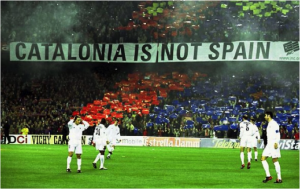
A display by FC Barcelona fans during El Clasico in Real Madrid’s Bernabeu stadium
When home-grown Barça players such as Busquets, Puyol and Gerard Piqué
meet Madridistas like Casillas and Arbeloa during next year’s soccer derby in Madrid, they will exchange a firm handshake of resentment but acceptance. After all, soccer is also the greatest example of Castilian-Catalan unity; the Spanish national team, star-studded with players from Real and Barça, has won the last World Cup and two consecutive Euro Cups. If consensus can be reached between hot-blooded soccer players, surely politicians in Barcelona and Madrid can compromise their wishes and remain under the same flag.
Marie Schulte-Bockum
International Affairs & Economics ‘17
[1] Stephen Burgen, “Catalans join hands in huge human chain for independence from Spain,” The Guardian, 19 September 2013.
[2]Josep Desquens, The Case for Catalonia’s Secession From Spain, http://www.jhubc.it/bcjournal/articles/desquens.cfm.
[3]Robert Lane Greene, “Hablen Español, Already”, The Economist, 24 January 2011
[4] Robert Lane Greene, “Language and nationalism: Catalonian confusion”, The Economist, 17 November 2012
[5] El Segadors – The Reapers, Anglophone Direct, http://www.anglophone-direct.com/Els-Segadors-Catalan-National (accessed 24 October 2013)
[6] Oliver Joy, Spain’s Next Threat: Losing 20% of its Economy, CNN News, 25 November 2012, http://www.cnn.com/2012/10/12/business/catalonia-independence-spain/
[7] Agence France Press (source), “Economic grudge fuels Catalan independence fight”, Global Post, 11 September 2013
[8] Joan Marc Simon, “Federalism and the future of Spain”, Federal Union, 10 May 2011
[9] Bull and donkey stickers on the Balearic islands, Balearic Travel, 12 February 2009, http://blog.mca-hotels.com/uk/2009/02/12/bull-and-donkey-stickers-in-the-balearic-islands/
[10] Cesar Guarde, “Francisco Caja’s ‘La Raza Catalana’”, AGON Grupo de Estudios Filosoficos
[11] Cesar Guarde, “Francisco Caja’s ‘La Raza Catalana’”, AGON Grupo de Estudios Filosoficos
[12] Cristina Gargallo, About Us, Catalan Tourist Board, http://cruise3sixty.com

